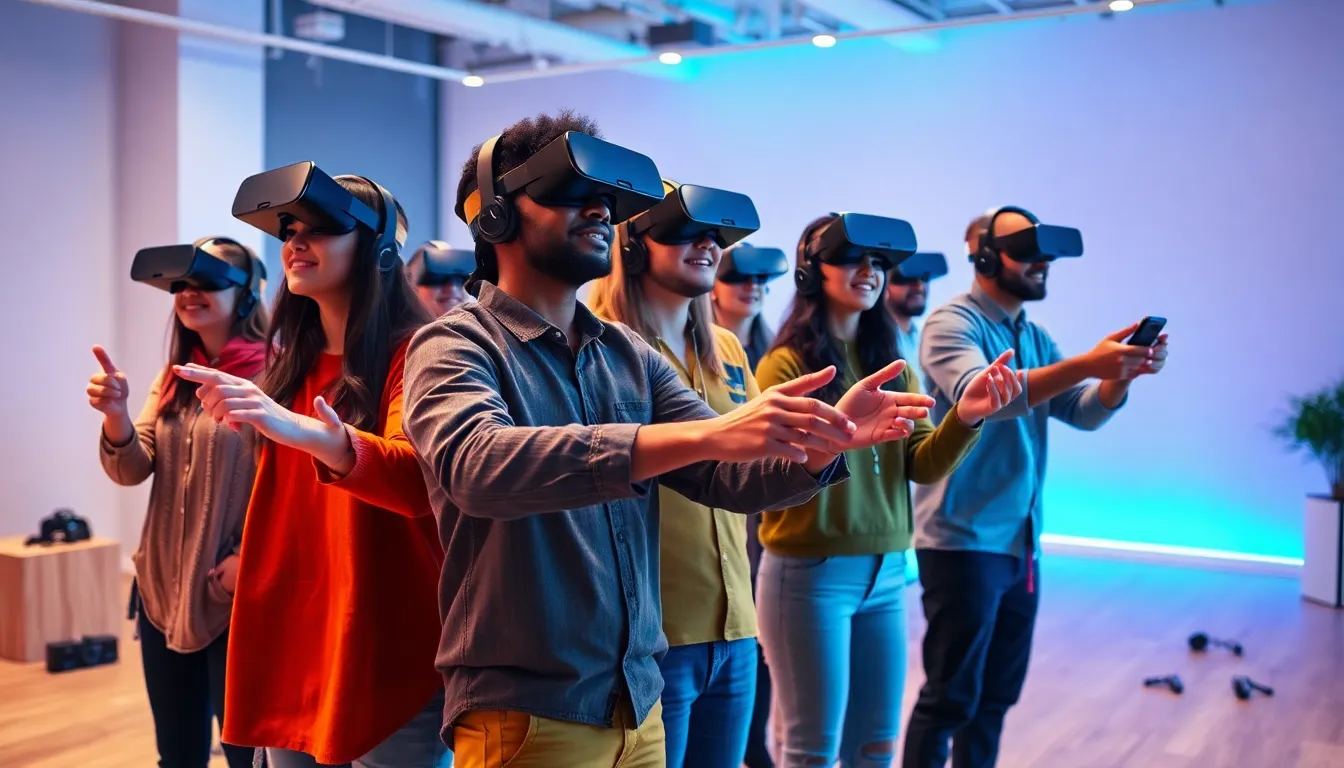Table of Contents
ToggleVirtual reality entertainment is transforming the way people experience games, movies, and interactive storytelling. With immersive technology advancing at lightning speed, it’s no surprise that audiences are drawn to the captivating worlds VR offers. This innovative medium allows users to step inside their favorite narratives, creating a sense of presence that traditional formats simply can’t match.
From thrilling adventures to serene explorations, VR entertainment caters to a wide range of interests. As the industry continues to evolve, it’s reshaping not just how stories are told but also how they’re experienced. The growing accessibility of VR devices means more people than ever can dive into these extraordinary experiences, making it a vibrant frontier in the entertainment landscape.
Overview of VR Entertainment
VR entertainment transforms user experiences across various platforms, including gaming, films, and interactive storytelling. Through immersive technology, it delivers unparalleled engagement, allowing users to interact with narratives in three-dimensional environments.
Gaming
VR gaming stands at the forefront of this revolution. Titles like “Beat Saber” and “Half-Life: Alyx” offer distinct experiences where players engage in physically immersive gameplay. Gamers can navigate virtual worlds, solve puzzles, and compete in real-time against others, creating a highly interactive setting.
Movies
VR cinema changes traditional film viewing. Productions such as “The Invisible Man” and “Wolves in the Walls” allow viewers to step inside narratives, enhancing emotional connections and altering perceptions of storytelling. Characters can interact directly with the audience, fostering a unique bond and experience.
Interactive Storytelling
Interactive storytelling in VR enables users to make choices that influence outcomes. Projects like “Wander” offer exploration and decision-making within expansive virtual realms. Such interactive narratives elevate user engagement, providing experiences that adapt based on actions.
Accessibility
The accessibility of VR devices expands audience reach. High-quality headsets like the Meta Quest 2 and Valve Index now cater to various price points, making VR experiences more available. Consequently, a growing number of users can participate in VR entertainment, fueling demand in the industry.
Future Trends
Emerging technologies promise further advancements in VR entertainment. Developments in haptic feedback, artificial intelligence, and 5G connectivity will enhance immersion and interactivity. These innovations signal a bright future, where VR entertainment continues to evolve and attract diverse audiences.
Types of VR Entertainment

Virtual reality entertainment encompasses various experiences that enhance engagement and interaction. These experiences range from gaming to concerts and immersive storytelling.
Gaming Experiences
Gaming experiences in VR offer unparalleled immersion through dynamic gameplay. Titles like “Beat Saber” and “Half-Life: Alyx” engage players in interactive environments, combining physical movement with strategic decision-making. Players can choose to battle through alien worlds or dance to music beats. VR gaming accessories, such as motion controllers and VR gloves, amplify interactivity, allowing users to manipulate virtual objects. The competitive nature of multiplayer games further enhances social interaction, making them popular among various age groups.
Virtual Concerts and Events
Virtual concerts and events reshape the entertainment landscape. Platforms like Wave and Oculus Venues provide attendees with front-row experiences in a shared virtual space. Artists such as Travis Scott and Lil Nas X have performed in VR, drawing millions of viewers. These events allow fans to engage with performers through avatars, creating a sense of presence despite physical distance. Users can also access exclusive backstage content and interact with fellow attendees, enhancing the overall experience.
Immersive Storytelling
Immersive storytelling in VR revolutionizes how narratives unfold. Experiences like “Wolves in the Walls” and “The Invisible Man” allow viewers to inhabit stories, making choices that influence plot directions. Users can explore environments and interact with characters, deepening emotional investment. Applications like “Demeo” offer role-playing scenarios where users collaborate to overcome challenges. These interactive narratives shift traditional storytelling, offering a unique blend of agency and engagement that captivates audiences.
Benefits of VR Entertainment
VR entertainment offers numerous advantages that enhance user experiences and interaction. Notably, VR immerses users in captivating environments, providing opportunities for engagement and social connection.
Enhanced Engagement
Enhanced engagement characterizes VR entertainment, allowing users to absorb themselves in interactive experiences. Activities such as gaming compel users to explore virtual worlds and react in real-time. VR titles like “Beat Saber” and “Half-Life: Alyx” deliver physically engaging gameplay, making users active participants rather than passive observers. The sense of presence VR offers leads to heightened emotional responses, fostering deeper connections to the narrative and environment. Additionally, immersive storytelling in experiences such as “Wolves in the Walls” creates personalized journeys where choices significantly impact outcomes, reinforcing engagement through user agency.
Social Interaction Opportunities
Social interaction opportunities grow within VR environments, transforming how users connect. Multi-user platforms foster collaboration and communication as friends and strangers engage in shared experiences. Users can team up in multiplayer games like “Rec Room” or attend virtual concerts, engaging with avatars in real-time. Events hosted on platforms such as Oculus Venues or Wave allows attendees to experience performances together, regardless of geographic barriers. These interactions cultivate stronger community bonds and enhance the overall enjoyment of events, showcasing the potential of VR beyond solitary experiences.
Challenges in VR Entertainment
Virtual reality entertainment faces several challenges that impact its growth and user experience. These challenges include technical limitations and health and safety concerns.
Technical Limitations
Technical limitations hinder the full potential of VR entertainment. Latency issues can disrupt immersion, leading to a disjointed experience that frustrates users. Current hardware often requires powerful specifications, restricting access to high-quality VR experiences. Additionally, the range of motion for VR content is frequently limited by physical space, making it challenging to create expansive environments. Furthermore, compatibility issues arise with various devices and platforms, complicating the ability to deliver a unified experience across systems. The development of more user-friendly interfaces and improved graphics processing is essential to overcoming these barriers.
Health and Safety Concerns
Health and safety concerns significantly affect user participation in VR entertainment. Motion sickness commonly arises from discrepancies between visual and physical movements, causing discomfort in some users. Eye strain can occur due to prolonged use of VR headsets, resulting in headaches and fatigue. As users navigate virtual environments, there is also the risk of physical injuries caused by collisions with real-world objects. Additionally, the social implications of VR experiences raise concerns about potential isolation and addiction. Addressing these health risks through better design, user education, and regular breaks can help mitigate their impact on VR enjoyment.
Future Trends in VR Entertainment
Future trends in VR entertainment encompass advancements that promise to revolutionize user experiences. Innovations in graphics and processing power enhance realism in virtual environments, making interactions more lifelike. Next-generation VR headsets, such as the Meta Quest 3 and PlayStation VR2, deliver improved resolution and tracking, positioning them as game-changers in the market.
Emerging technologies like haptic feedback and augmented reality integration foster immersive interactions. Haptic feedback suits, gloves, and vests provide tactile responses, allowing users to feel virtual objects and environments. Meanwhile, augmented reality enhances real-world surroundings with VR elements, creating hybrid experiences that blend physical and digital realms.
AI applications reshape content creation, personalizing experiences to individual preferences and behavior. AI-driven algorithms can analyze user interactions, adapting narratives and gameplay dynamically. This personalization enhances engagement, maintaining user interest over extended periods.
5G connectivity enhances VR experiences by minimizing latency and enabling real-time interactions. The increased bandwidth supports multiplayer functionalities, allowing users to engage seamlessly in shared experiences, such as live events or multiplayer games.
Streaming services specializing in VR content are on the rise. Platforms like VRChat and AltspaceVR facilitate user-generated content and social events, fostering community participation. This trend encourages collaborative experiences, enhancing social interaction and vibrant ecosystems in the virtual landscape.
Furthermore, educational applications are gaining traction, utilizing VR for training and simulation. Industries such as healthcare, aviation, and manufacturing employ VR for realistic scenario training, preventing costly errors and enhancing learning outcomes.
As VR technology evolves, gamification elements within non-gaming applications will become commonplace. Companies will incorporate game-like features in marketing, education, and wellness applications, engaging users in new and interactive ways.
The future of VR entertainment promises heightened realism, personalization, and community engagement, paving the way for innovative applications across various sectors. These developments will shape immersive experiences that resonate with users, enhancing their enjoyment and connection to virtual environments.
The evolution of VR entertainment is reshaping how individuals experience games movies and interactive storytelling. With its ability to immerse users in captivating environments the potential for deeper emotional connections and social interactions is unprecedented. As technology continues to advance the accessibility of VR devices expands the audience and enhances the overall experience.
Addressing the current challenges will be essential for maximizing enjoyment and participation. Innovations in hardware and software will pave the way for a more engaging future where VR becomes an integral part of entertainment. As this dynamic sector continues to grow it promises to offer even more thrilling and personalized experiences that keep users coming back for more.




